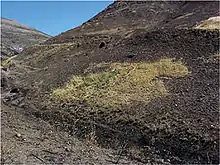| Blepharizonia plumosa | |
|---|---|
 | |
| Plant surviving after a brushfire | |
| Scientific classification | |
| Kingdom: | Plantae |
| Clade: | Tracheophytes |
| Clade: | Angiosperms |
| Clade: | Eudicots |
| Clade: | Asterids |
| Order: | Asterales |
| Family: | Asteraceae |
| Genus: | Blepharizonia |
| Species: | B. plumosa |
| Binomial name | |
| Blepharizonia plumosa | |
| Synonyms[1] | |
| |
Blepharizonia plumosa is a California species of tarweed known by the common name big tarweed. It is endemic to central California, where it grows in the Central Coast Ranges and adjacent sections of the southern San Francisco Bay Area and Central Valley, from southern Sonoma County south as far as San Luis Obispo County.[2]
Description
This is a glandular, aromatic annual herb producing a hairy, erect stem which may approach two meters (80 inches) in height. The leaves are linear in shape and sometimes toothed, the largest located near the base of the plant reaching 15 centimeters (6 inches) long. The inflorescence bears several flower heads, each with a fringe of up to 13 red-veined white ray florets just under a centimeter long. The center of each head is filled with protruding tubular disc florets with large dark anthers. The fruit is a hairy, club-shaped achene which may or may not have a pappus at the tip.[3]
Blepharizonia is sometimes treated as a monotypic genus, and sometimes as a genus with two species. One variety or subspecies of B. plumosa is sometimes treated as a distinct species called Blepharizonia laxa.[4][3]
References
- ↑ The Plant List, Blepharizonia plumosa (Kellogg) Greene
- ↑ Calflora taxon report, University of California, Blepharizonia plumosa (Kellogg) E. Greene, big tarweed
- 1 2 Flora of North America, Blepharizonia plumosa (Kellogg) Greene
- ↑ Greene, Edward Lee 1885. Bulletin of the California Academy of Sciences 1(4D): 279
External links
- Calflora Database: Blepharizonia plumosa (Big tarweed)
- Jepson Manual Treatment
- United States Department of Agriclulture Plants Profile
- Calphotos Photo gallery, University of California